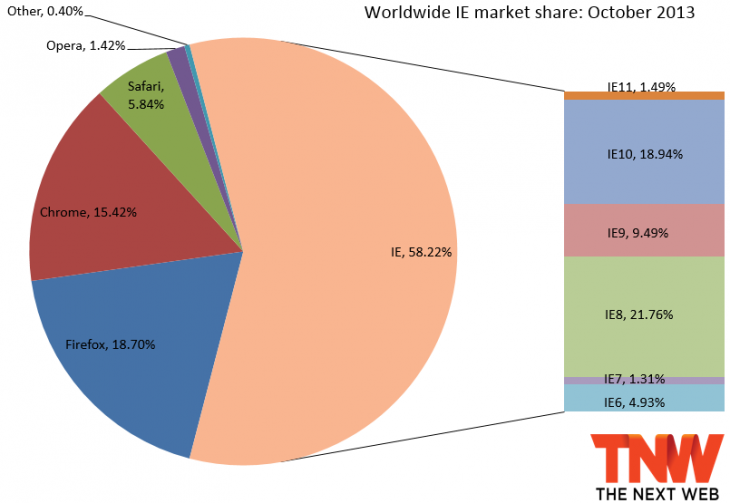As we move into the fourth quarter of 2013′s browser war, October saw the release of IE11 along with Windows 8.1, the launch of Firefox 25, and the debut of Chrome 30. The latest market share numbers from Net Applications show Chrome was the biggest loser last month.
Between September and October, IE gained 0.42 percentage points (from 57.80 percent to 58.22 percent), Firefox moved up 0.10 percentage points (from 18.60 percent to 18.70 percent), and Chrome fell 0.54 percentage points (from 15.96 percent to 15.42 percent). Safari meanwhile gained 0.07 percentage points to 5.84 percent and Opera slipped 0.05 percentage points to 1.42 percent.
At 58.22 percent, Internet Explorer has hit a new high for the year. January was the first time the browser went back above the 55 percent mark, and it has steadily shown it won’t be losing that crown anytime soon, edging ever closer to the 60 percent mark.
At 18.94 percent in October,’E10′s market share is no longer increasing, having fallen 0.49 percentage points. This is largely due to IE11, which grabbed 0.58 percentage points (from 0.91 percent to 1.49 percent). Meanwhile, IE9 added another 0.05 percentage points to its tally, hitting 9.49 percent. Soon IE11 will be following in its predecessor’s footsteps, hopefully stealing share from older versions.
IE8 unfortunately managed to gain 0.35 percentage points, and it’s still the world’s most popular browser at 21.76 percent. The real tragedy here is that IE10 mainly stole share from IE9 on Windows 7, since Windows XP users can’t upgrade past IE8, and IE11 will likely be no different.
IE7 was down 0.06 percentage points to 1.31 percent and IE6 managed to regain 0.06 percentage points, to 4.96 percent. Last month, IE6 finally fell below the 5 percent mark, and thankfully it didn’t regain all of its losses.
At 18.70 percent, Firefox seems to be hovering again. The last four months aside, the last time we saw the browser at 18 percent was way back in May 2008. Firefox 25 was just released this week, so it only managed to grab 0.76 percent share (more than IE11 of course, since Firefox users didn’t have to upgrade their OS), while Firefox 24 hit 12.79 percent. All the other versions lost share: Firefox 23 fell 10.29 points, Firefox 22 lost 0.23 points, and Firefox 21 dipped 0.07 points.
At 15.42 percent, Chrome has hit a 27-month low. Chrome 30 grabbed 10.45 percentage points after arriving on the first day of the month. All other versions were down: Chrome 29 lost 10.38 points, Chrome 28 slipped 0.41 points, while Chrome 27 and Chrome 26 lost a combined 0.10 points.
Net Applications uses data captured from 160 million unique visitors each month by monitoring some 40,000 websites for its clients. StatCounter is another popular service for watching market share moves; the company looks at 15 billion page views. To us, it makes more sense to keep track of users than page views (for more, see this post).
Nevertheless, for October 2013, StatCounter listed Chrome as first with 40.42 percent market share, IE in second with 28.95 percent, Firefox in third with 18.10 percent, Safari with 8.57 percent, and Opera with 1.20 percent. The only part everyone agrees on is that Safari and Opera are not in the top three.
See also – Windows 8 drops to 7.53% market share, falling for the first time as Windows 8.1 takes 1.72% share
Top Image Credit: Hugo Humberto Plácido da Silva
via The Next Web http://feedproxy.google.com/~r/TheNextWeb/~3/G4gmwDI5NK8/







0 comments:
Post a Comment